From the time you let go of the bowling ball, the bowling ball is slowing down. The fastest the bowling ball rolls is when it first comes off of your hand. Simultaneously, the bowling ball has the most axis rotation at the point of release, and its axis rotation lessens as the bowling ball travels down lane.
When a bowling ball successfully travels through the three phases of ball motion, skid, hook, and roll, you’ll know you are “matched up” with the correct bowling ball, imparting the correct speed and rotation for your style of play.
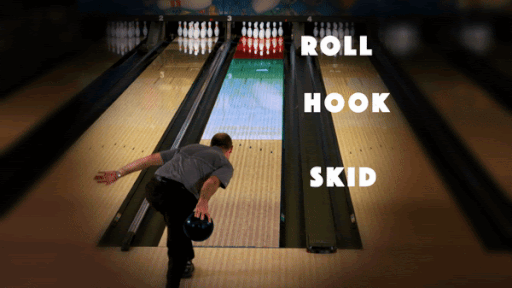
Skid Phase
The skid phase occurs from the foul line to the arrows (first 15 feet). The highest volume of oil is generally concentrated in this area. The bowling ball is at its fastest speed with its most axis rotation, giving the bowling ball the ability to skid through the oil.
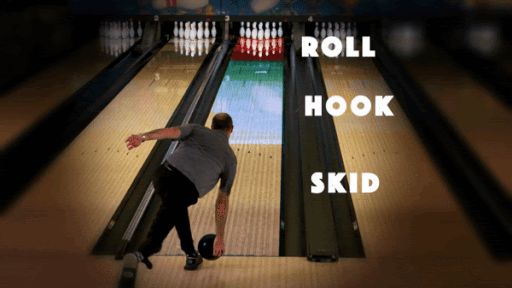
Hook Phase
The most complicated part of ball motion to understand is the hook phase. The hook phase occurs from the arrows to the range finders (15 to 45 feet). The bowling ball is now losing speed, and it will begin to get into a more end-over-end roll while beginning to change direction (right to left) in a controlled manner.
You do not want the bowling ball to enter the hook phase too early or too late. In order to identify this, you need to start looking at the lane front-to-back instead of side-to-side. The roll phase is what determines if your bowling ball is in the hook phase too early, too late, or just right.

Roll Phase
The roll phase happens in the last 15 feet on the lane. The bowling ball hits the breakpoint and straightens out, heading towards the pocket. Once the bowling ball makes its motion toward the pocket, it eventually runs out of energy, and it is rolling at its slowest speed with the least amount of axis rotation.
The bowling ball needs to be in a roll when it hits the pins. This gives you the least amount of pin deflection, resulting in more strikes.
When the bowling ball is properly in the roll phase, you will see the bowling ball hit the 1, 3, 5, 8, and 9 pins.

Note how the ball continues to drive through the pins. If it deflects, the bowling ball didn’t get into a proper roll, meaning that it is not matching up to the speed and rotation you are imparting on it.
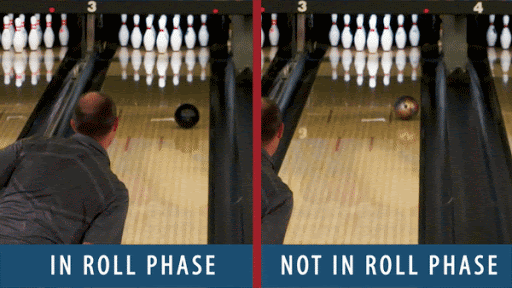
This is what tells you to move your feet on the approach, move the target with your eyes, change the bowling ball’s surface, or change bowling balls to better match up to what the lane is giving you.
Another example of the bowling ball not being in the roll phase properly is when it drives too hard when it hits the pocket or goes through the nose. The ball will hit the 1, 3, 5, and 8 pins, missing the 9 pin. Moving two boards left with your feet on the approach and one board left with your target should get you back into a proper roll phase.
If the ball drives really hard through the nose or even crosses over, sometimes moving four boards left with your feet and two boards left with your eyes can be required to get your back into the proper roll phase. Remember, none of this is possible to observe if you do not hold your finish position, aka post your shot. Hold that position until the ball goes through the pins and falls off the pin deck.
Bowling can be an unforgiving sport, and you need to know how to look at the results without overanalyzing or overreacting.
Reacting to What Happened Without Overanalysis
There is a time and place for everything when bowling. The settee is a time for thought, and the approach is a time for action. Think of these two areas as the playing box and the thinking box.
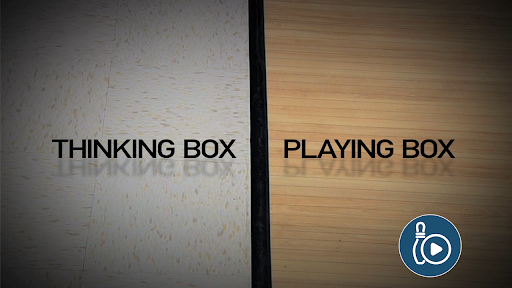
After you release your shot, it is time for observation without judgment. Posting your shot until the ball rolls through the pins and falls off the deck will allow you to gather the information required to make adjustments.
Standing next to the ball return is the time to plan for what’s in front of you, like what board you are going to stand on and which ball you’re going to use.
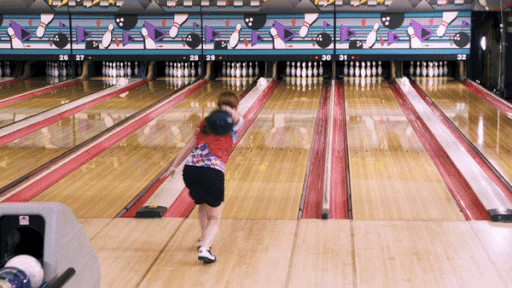
If you’re shooting at a spare, it is not time to evaluate the previous strike shot. You can do that back in the settee while you’re waiting for your next shot after you make your spare.
By delaying strike shot adjustment thoughts, you will keep your focus on what’s in front of you so you can go about making the spare and avoid mental lapses resulting in an open frame.
Natural Instincts
You likely work on your physical game regularly while diagnosing your lane play, but how often do you work on your mental game? Letting your training kick in and bowling with natural instincts without overthinking is a formula for success in bowling.
For more detailed instruction, read “The Inner Game of Golf” by Timothy Gallwey and “Freedom Flight: The Origins of Mental Power" by Lanny Bassham.
Check out more mental game videos from our expert coaches that will help you improve and prepare for your next competition.

What if your ball doesn’t skid? How do you adjust?
Excellent article. Additionally, ball selection and speed control play a major part in how your ball drives through the pocket.
I’ve been getting to many splits My ball doesn’t hook to much
What can I do or move left or right when I continuely get a 10,pin standing?